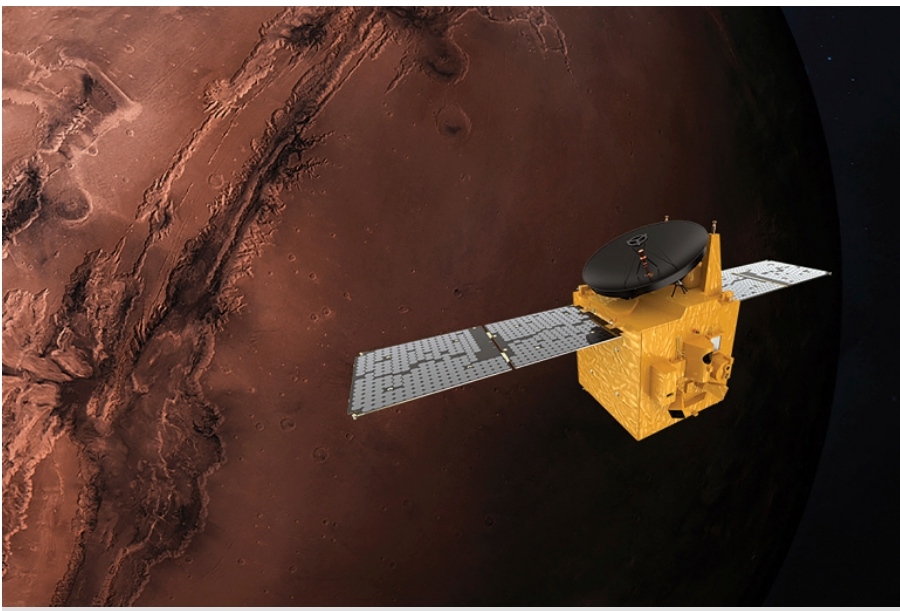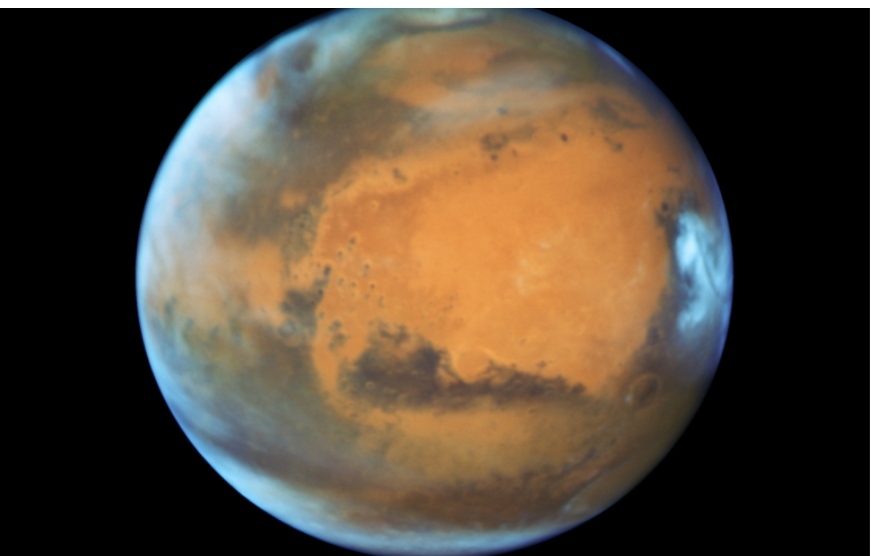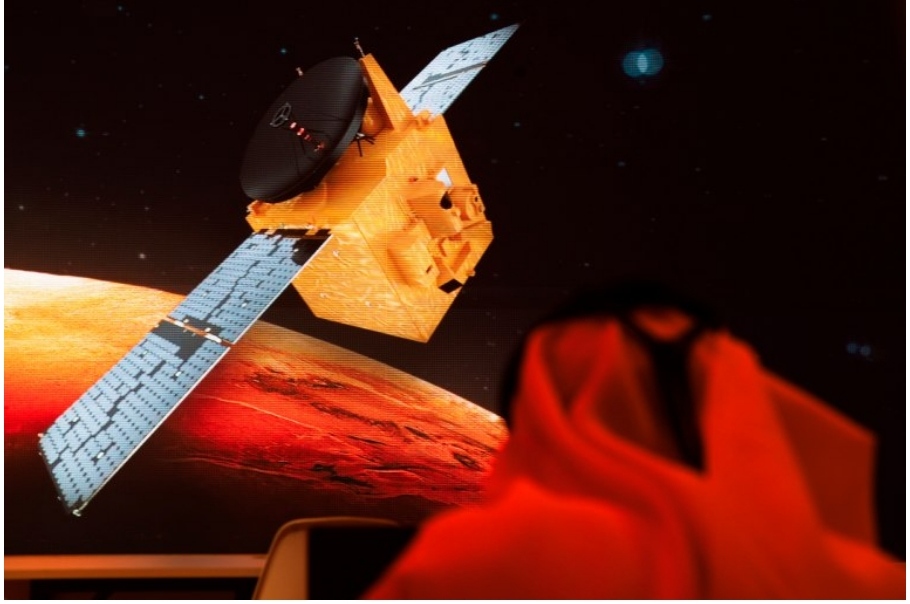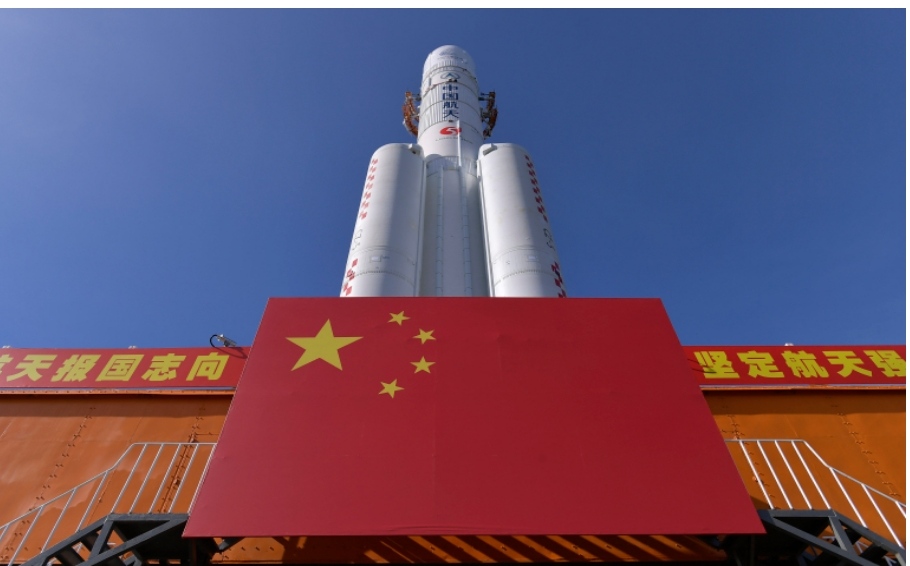UAE’s space probe Amal enters orbit of Planet Mangal

After the Indian space mission to Planet Mangal, The United Arab Emirates’ will become the second Asian Country to reach there successfully. Its first Mangal mission has entered the red planet’s orbit after a seven-month and 494 million kilometres journey, allowing it to start sending data about the atmosphere and climate.
Officials at mission control broke into applause on Tuesday, visibly relieved after a tense half-hour as Amal, Arabic for hope, carried out a “burn” to slow itself enough to be pulled in by the gravity.
“To the people of the UAE, to the Arab and Muslim nations, we announce the successful arrival to The planets orbit. Praise be to God,” said Omran Sharaf, the mission’s project manager.
Amal had to perform a series of turns and engine firings to manoeuvre into orbit, reducing its speed to 18,000kmph (11,200mph) from more than 121,000kmph (75,000mph).
Tuesday’s announcement makes UAE’s space agency the fifth to reach Mangal. The NASA the American Space Agency, the Russian Space Agency, ISRO the Indian Space Agency European Space Agency were there before.
Probes launched by China and NASA just after the UAE’s lift-off in July last year are also set to reach the planet this month.
The Emirates Mission, which has cost approximately $200m, launched the Hope Probe from a Japanese space centre.
The programme is part of the UAE’s efforts to develop its scientific and technological capabilities and reduce its reliance on oil. Its space agency has a plan for a settlement there by 2117.
It aims to provide a complete picture of the atmosphere for the first time, studying daily and seasonal changes.

The unmanned missions promise to yield new insights for Earth-bound scientists intent on unravelling the mysteries of the solar system.
The Red Planet is about to get a little crowded. Three separate missions to launched by the United States, China and the United Arab Emirates (UAE) will all reach their destination this month after taking flight within just 11 days of each other in 2020.
The uncrewed missions promise to yield new insights for Earth-bound scientists intent on unravelling the mysteries of the solar system and scanning The Red Planet for signs of extraterrestrial life, as well as enhancing our collective understanding of the cosmos.
But the ventures are also the latest landmark in the new geopolitical space race, say experts, as the world’s most powerful nations once again compete with one another for dominance beyond Earth’s surface.
Each of the ventures has “different aims and capabilities. The US and Chinese missions, which come against the backdrop of an intensifying geopolitical rivalry between the two nations, include plans to land exploratory rovers on the planet, while the UAE is focused on surveying it from above via an orbiter.
The UAE’s mission will be the first to arrive in orbit on Tuesday, ushering in a new era of space exploration for the Gulf nation.
Al Amal will spend 687 days — a period equivalent to one year on Mangal — gathering information on the atmosphere and surveying the planet’s weather patterns throughout its four seasons.
In doing so, it may shed light on the mystery of Planets transformation from a warm, wet world – one with an atmosphere thick enough to support liquid water on its surface, and potentially capable of supporting life – into the cold and barren planet it is today.
Matthew Siegler, a research scientist at the non-profit US-based Planetary Science Institute, said the probe’s findings could help to determine when conditions conducive to life existed on Mangal.
“The atmosphere is presently too thin for liquid water to be stable on the surface,” Siegler told Al Jazeera. “By carefully measuring the atmosphere, we can better model how long ago the atmosphere may have been suitable for liquid water on the surface, and therefore potentially suitable for life.”
As well as promising to improve our understanding of Planets past, the craft’s research could also guide scientists’ planning for future missions and enhance their understanding of whether the fourth planet from the sun has the potential to receive human visitors — or, in the longer term, settlers, the head of the UAE Mars mission’s, said Omran Sharaf,.

Wendy Whitman Cobb, an associate professor of Strategy and Security Studies at the US Air Force’s School of Advanced Air and Space Studies, told Al Jazeera the venture had an underlying motivation “to drive domestic interest in space exploration”.
“The UAE is essentially using this mission to stimulate a homegrown space programme,” she said, noting space exploration “continues to be a means by which countries not only demonstrate their technical capabilities but compete for global prestige”.
“Though [the UAE] designed and paid for this mission, it was built in the US and launched in Japan, so they need to develop the talent domestically to begin to do these types of things on a more regular basis,” Whitman Cobb added.
The China National Space Administration has kept the goals of its inaugural mission to The Red Planet, named Tianwen-1, or “Questions to Heaven”, closely guarded.
What is known is that its probe is expected to make orbital insertion on February 10, eight days before the craft guided by US space agency NASA is scheduled to arrive at the Red Planet with its Perseverance rover in tow.
Although China’s probe will beat NASA’s in arriving at Mangal, its lander component isn’t scheduled to attempt to touch down on the planet’s surface first. Instead, the plan is to keep it in orbit for two or three months, attached to the cruise ship that has been shepherding it through outer space before eventually touching down.
China’s lander is anticipated to eventually make its hazardous descent to Utopia Planitia — Mangal’s largest impact crater — sometime in May, after which it will release a six-wheeled, solar-powered rover robot.
The rover, which weighs about 240kg (529 pounds), will spend the next three months scouring the Red Planet’s surface, examining its geology and searching for pockets of water beneath the surface, which could contain signs of life.
Meanwhile, the cruise ship that is taking the rover will remain in orbit, studying the planet’s atmosphere using a suite of remote-sensing instruments.
The orbiter, which will also combine with the rover for high-speed data relay, is designed to operate for 687 days, mirroring the Mangal calendar and the length of the UAE’s probe.

“The Chinese mission further demonstrates not only that they’re serious about space, but that they are as capable as the US,” Whitman Cobb said, noting that both countries’ expeditions have a “political undertone”…..Chine are still smarting of the fact that they were beaten to the race for planet Mangal by the Indians.
“While competition might not be the primary driver of these missions, it is safe to say that it is part of the calculation,” she added.
China is very ambitious, with plans for a moon base and eventually a base, and their own space station. They are spending heavily, and success in space is directly tied to national pride and the projection of Chinese power.
China may be hot on its heels, but the US is still the frontrunner in the dash to explore our solar system.
Todd Harrison is the director of the Aerospace Security Project and a senior International Security Program fellow at the Center for Strategic and International Studies, a Washington, DC-based think-tank.
Harrison told Al Jazeera that the US has retained “a substantial lead in space exploration and space technology”, but “China and other nations are working diligently to catch up.”
The US has successfully landed on Mangal eight times since its first such venture in 1976 and is still the only country to have put astronauts on the moon during the 1969 to 1972 Apollo missions.
NASA’s six-wheeled Perseverance rover is set to touch down on February 18 near the equatorial Jezero Crater. Weighing 1,025kg (2,260 pounds), the nuclear-powered and car-sized Perseverance is the most sophisticated explorer ever dispatched to another planet and will spend at least as long as two Earth years on the Red Planet, collecting information and, crucially, samples from its rocks and soil.
Provided NASA’s probe safely navigates a harrowing final descent to the surface, known by engineers as the “seven minutes of terror” — a reference to the time it takes a craft to get down from the top of Mars’s atmosphere — the agency’s mission could prove the most pivotal to date in terms of humanity’s understanding of Mangal.
“Perseverance is the first step of a multi-mission attempt to return samples of to the Earth,” Casey Dreier, chief advocate and senior space policy adviser at The Planetary Society, a US-based nongovernmental organisation, told Al Jazeera.
“That’s been a goal of the science community for something like 50 years, and probably the most ambitious robotic project ever attempted,” he added. “The scientific payoff could be immense.”
“The rover will land to collect samples in an area where scientists believe liquid water was present for a time in Mangal history when life could have existed,” he explained. “It is also going to an incredibly interesting water feature — a delta where a river once poured out into a lake, which is one of the most unique geologic features we have ever explored on Mangal and a prime target for hunting for signs of past life.”
Armed with a host of scientific instruments and gadgets, including a detachable miniature helicopter, Perseverance will also help NASA prepare for possible future human missions, according to the US space agency.
The mission, it would appear, is a precursor to plenty more US activity that NASA is planning on the planet in the years and decades to come.
More widely, Whitman Cobb said, it symbolises the country’s effort to maintain its current “advantage” in outer space.
On the cusp of this month’s flurry of Mars exploration activity, there are clear concerns among experts about the potential militarisation of space, especially when it comes to the US-China rivalry.
“Cooperation is a political choice,” Harrison said. “As long as we …..the US and China…. He has managed to forget Russia and India ….have shared exploration goals, which we clearly do, then we should be able to find a way to cooperate with one another, despite our disagreements in other areas.”
“National pride certainly plays a role in high-profile space missions like these, but I think the ultimate driver is a quest to explore and learn more about our solar system,” he added.
Taken together, Impey said, these sojourns to Mars by the US, China and the UAE promise to deliver “a great step forward” in our ability as humans to conduct complex missions in space as well as “a sign that one day, we may master the entire solar system, and live off Earth”.
At a moment when life on Earth remains mired in the chaos and tragedy of the coronavirus pandemic, watching science expand both the edges of what we know and what we think is possible promises to be particularly poignant, Siegler said.
“Exploration always brings hope — the hope of a better tomorrow,” he said. “We can all still push ahead on great things even in the face of a global challenge.”




